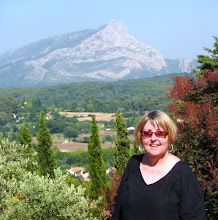The lower attached area to the left is part of the living quarters.
Below are the living room and kitchen.
The De Valk (Falcon) dates from 1743.
Peeking out a window on the way up.
Views on and from the sail deck.
I loved this shot so much that I made this picture my wallpaper for the year. It's so Dutch.
This family was from Texas, I think. The little girl was fearless.
So were these folks.
Trout not so much. Here he is close to one of the sail controls. It is still done by hand.
This deck does have a modern treatment. It's Trex or something similar. You do not want to be walking up here in heels of any kind. The separations and holes are totally open to the ground below.
Now we're back inside. If you click on the link at the beginning, it will take you to a schematic that you can click on to find out what all the levels are and what was done on them.
Trout liked these big gears and every other mechanical thing on these levels.
These things were not glued down. People could pick them up, but there was a camera to make sure you didn't take them with you.
More good mechanical stuff.
Let's get a closer look at that.
The stairs up and down were narrow and steep, often more like ladders than stairs.
This is how they got the grain up and the flour down, not to mention the grindstones -- through trap doors like this one. They are often right at the tops or bottoms of the stairs.
This little hand-done sign tells you how to go up and down the stairs in 4 languages.
I don't think we were allowed to go up these at all.
This is the last set of stairs down to the ground.
Now we're back on the ground at the door where the horse wagons came in to supply the mill with grain and take the flour away. There are some grindstones and a couple of other relics of times past.
Back outside, this is one of the horse-drawn mills.
This visit to the Molen De Valk was one of my favorite things about the trip. I love seeing the technologies people used to do the work needed to live during their times.











































